In-depth analysis: 5G and future antenna technology.

In the past two decades, we have witnessed the transformation of mobile communications from 1G to 4G LTE. During this period, the key communication technology is changing, and the amount of information processed has doubled. The antenna is an indispensable component to achieve this leapfrog improvement.
According to the industry's definition, an antenna is a converter that transforms the guided wave propagating on a transmission line into an electromagnetic wave propagating in an unbounded medium (usually free space), or vice versa, that is, transmitting or receiving electromagnetic waves. In layman's terms, whether it is a base station or a mobile terminal, the antenna acts as a middleware for transmitting and receiving signals.
Now, the next-generation communication technology-5G has entered the end of the standard formulation stage, and major operators are also actively deploying 5G equipment. There is no doubt that 5G will bring a brand new experience to users. It has a transmission rate ten times faster than 4G, and puts forward new requirements on the antenna system. In 5G communications, the key to achieving high rates is millimeter wave and beamforming technology, but traditional antennas obviously cannot meet this demand.
What kind of antenna is needed for 5G communication? This is a question that engineering developers need to think about.
The evolution and trend of mobile communication base station antennas
Base station antennas are developed along with network communication, and engineers design different antennas according to network requirements. Therefore, in the past several generations of mobile communication technology, antenna technology has also been evolving.
Almost all omni-directional antennas were used in the first generation of mobile communications. At that time, the number of users was small and the transmission rate was low. At this time, it was still an analog system.
We have entered the cellular era with the second generation of mobile communication technology. The antenna at this stage has gradually evolved into a directional antenna, and the general lobe width includes 60°, 90° and 120°. Taking 120° as an example, it has three sectors.
Antennas in the 1980s were mainly single-polarized antennas, and the concept of arrays had already been introduced. Although omnidirectional antennas also have arrays, they are only vertical arrays. Single-polarized antennas appear as planar and directional antennas. In terms of form, the current antenna is very similar to the second-generation antenna.
In 1997, dual-polarized antennas (±45° crossed dual-polarized antennas) began to take the stage of history. The antenna performance at this time has been greatly improved compared to the previous generation. Whether it is 3G or 4G, the main trend is dual-polarized antennas.
In the 2.5G and 3G era, many multi-band antennas have appeared. Because the system at this time is very complicated, such as GSM, CDMA, etc., need to coexist, so multi-band antennas are an inevitable trend. In order to reduce costs and space, multiple frequency bands have become mainstream at this stage.
In 2013, we introduced the MIMO (Multiple-Input Multiple-Output) antenna system for the first time. Initially it was a 4×4 MIMO antenna.
MIMO technology has increased the communication capacity. At this time, the antenna system has entered a new era, that is, from the initial single antenna to the array antenna and multiple antennas.
However, now we need to look far away. The deployment of 5G has already started. What role will antenna technology play in 5G, and what impact will 5G have on antenna design? This is the question we need to explore.
In the past, the antenna design was usually very passive: after the system design was completed, the index was raised to customize the antenna. However, the current concept of 5G is still unclear. Researchers who do antenna design need to prepare in advance to provide solutions for 5G communication systems, and even influence the customization and development of 5G standards through new antenna solutions or technologies.
Judging from the cooperation and exchange experience with mobile communication companies in the past few years, there are two major trends in base station antennas in the future.
The first is from passive antenna to active antenna system:
This means that the antenna may be intelligent, miniaturized (co-designed), and customized.
Because the future network will become more and more detailed, we need to customize the design according to the surrounding scenes. For example, the deployment of stations in urban areas will be more refined, rather than simple coverage. 5G communications will use high frequency bands, obstacles will have a great impact on communications, customized antennas can provide better network quality.
The second trend is the systematic and complex antenna design:
For example, beam array (to achieve space division multiplexing), multi-beam and multi/high frequency bands. These all put forward high requirements on the antenna, which will involve the entire system and compatibility issues. In this case, the antenna technology has surpassed the concept of components and gradually entered the system design.
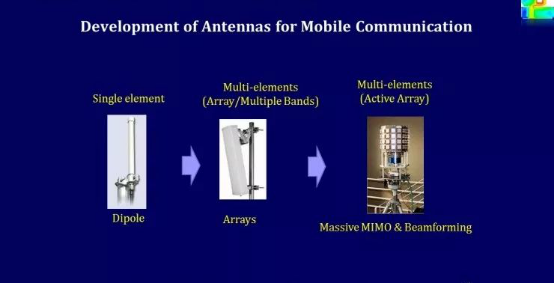
The evolution of antenna technology: the earliest from a single array of antennas to multiple arrays to multiple units, from passive to active systems, from simple MIMO to massive MIMO systems, and from simple fixed beams to multiple beams.
Trends at the design level:
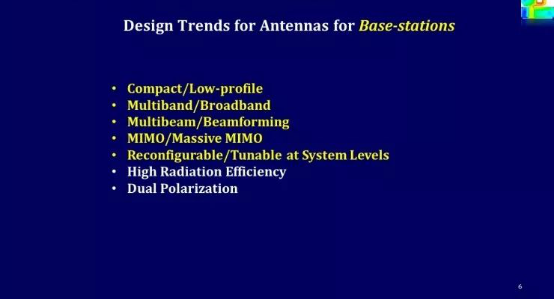
For base stations, a major principle of antenna design is miniaturization.
Antennas of different systems are designed together. In order to reduce costs and save space, they must be small enough. Therefore, the antennas need to be multi-band, wide-band, multi-beam, MIMO/Massive MIMO, and MIMO isolation. Massive MIMO has some special requirements for hybrid mutual coupling of antennas.
The antenna needs to be tunable:
The first-generation antenna was mechanically realized inclination, and the third-generation realized remote ESC. If 5G can realize self-tuning, it is very attractive.
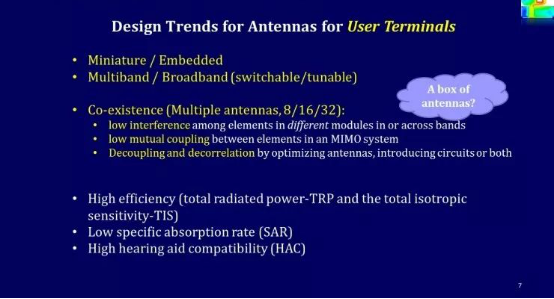
For mobile terminals, the requirements for antennas are also miniaturization, multi-band, wide-band, and tunable. Although these features are now available, the requirements of 5G will be even more demanding.
In addition, the antenna of 5G mobile communication also faces a new problem-coexistence.
To achieve Massive MIMO, multiple antennas are required for both sending and receiving, that is, multiple antennas at the same frequency (8 antennas, 16 antennas.). The biggest challenge that such a multi-antenna system brings to the terminal is the problem of coexistence.
How to reduce the mutual influence to couple, how to increase the channel isolation. This puts forward new requirements for 5G terminal antennas.
Specifically, the following three points will be involved:
Reduce the mutual influence, especially the mutual interference between different functional modules and different frequency bands. Previously, academic circles thought that this would not exist, but this problem does exist in the industry;
Decoupling. In a MIMO system, the mutual coupling of antennas will not only reduce the channel isolation, but also reduce the radiation efficiency of the entire system. In addition, we cannot expect to rely entirely on high-frequency millimeter waves to solve the performance increase, for example, 25GHz, 28GHz. 60GHz all have system problems;
Decorrelation, this can be solved by the cooperation of antenna and circuit design, but the bandwidth of the solution through the circuit is very limited, and it is difficult to meet the bandwidth of all frequency bands.
Antenna technology of 5G system
This includes the design of a single antenna and the technology at the system level, as mentioned above at the system level, such as multi-beam, beamforming, active antenna array, Massive MIMO, etc.
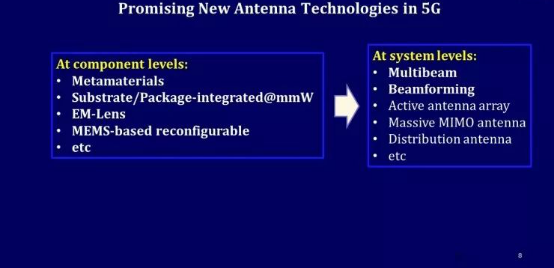
From the perspective of specific antenna design, the technology developed from the concept of metamaterials will be of great benefit. At present, metamaterials have achieved success in 3G and 4G, such as miniaturization, low profile, high gain, and high frequency bands.
The second is the substrate or package integrated antenna. These antennas are mainly used in higher frequency bands, that is, millimeter wave bands. Although the size of the high-frequency antenna is small, the loss of the antenna itself is very large, so it is best to integrate the antenna with the substrate or a smaller package on the terminal.
The third is an electromagnetic lens. The lens is mainly used in the high frequency band. When the wavelength is very small, a medium can be used to focus. The high-frequency antenna is not large, but the wavelength of the microwave band is very long, which makes the lens difficult to use. It will be big.
The fourth is the application of MEMS. When the frequency is very low, MEMS can be used as a switch. In a mobile phone terminal, if the antenna can be effectively controlled and reconstructed, one antenna can be used for multiple purposes.
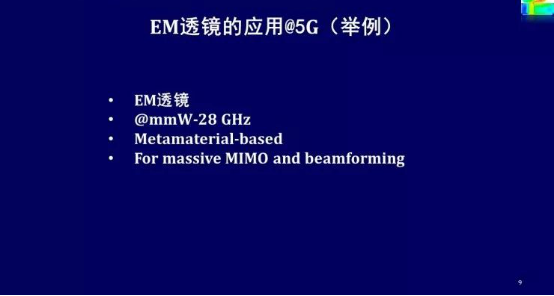
Taking electromagnetic lens as an example, this design introduces a concept: an electromagnetic lens is placed in front of the multi-element antenna array (here refers to the lens applied to the low-end frequency band of microwave or millimeter wave, which is different from the traditional optical lens). After incident from a certain angle, a spot will be generated on a certain focal plane. This spot concentrates a large amount of power, which means that the main part of the entire power is received in a small area.
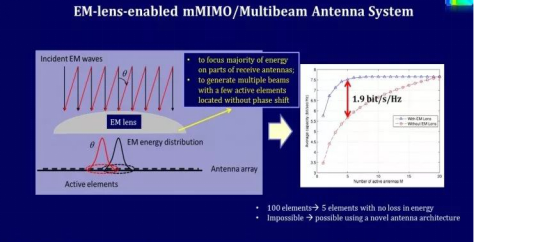
When the incident direction changes, the position of the spot on the focal plane also changes. As shown in the figure above, when the angle is projected forward, a black color energy distribution is produced. If it is incident at a certain angle θ (red color), the main energy deviates from the black color area.
This concept can be used to distinguish where the energy comes from. The direction of incidence and the position of the energy on the array or focal plane are in one-to-one correspondence. Conversely, if the antenna is excited at different positions, the antenna will radiate in different directions, which is also a one-to-one correspondence.
If you use multiple units to radiate on the focal plane, you can generate radiation from multiple carrier beams, which is called beamforming; if you switch between these beams, beam scanning will occur; if these antennas are used at the same time, You can achieve Massive MIMO. This array can be very large, but only a few arrays on each beam can achieve high-gain radiation.
If an ordinary array has the same caliber, the energy received each time is that all units must receive energy in this area. If only one unit is placed in a large area, the energy received is only a very small part; and ordinary The difference between the array is that the same caliber can receive all the energy with only a few units without any loss. When coming in from different angles, these energy can be received at the same time in different places.
This greatly simplifies the entire system. If there is only one direction at a time, only one local antenna can work, which reduces the number of antennas that work at the same time. The concept of sub-array is different. It allows local multiple antennas to form a sub-array. At this time, the number of channels decreases as the number of sub-array elements increases. For example, a 10×10 array, if 5×5 is used as a sub-array, then there are only four independent channels, and the total number of channels is reduced.
The right side of the figure above shows the influence of the lens on the system calculated on the baseband. The horizontal direction is the number of antennas. Assuming that there are 20 elements in a linear array in the horizontal direction, when the lens is used, only 5 elements are used to accept The focused energy is better than using all 20 units without a lens. The former has higher communication quality, lower cost and lower power consumption. Even in the worst case, when the wave is incident from all directions, the effect of using these 20 units is the same as the latter. Therefore, the use of lenses can improve the performance of the antenna-with a small number of antennas, the effect of the previous large-scale array can be achieved.
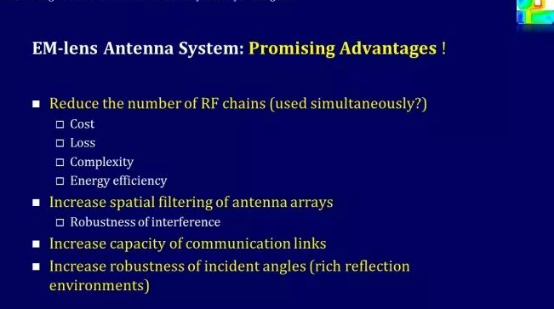
It can be seen from this PPT that the use of electromagnetic lenses can reduce costs, reduce complexity, increase radiation efficiency, and increase the filtering characteristics of the antenna array (shielding interference signals) and so on.
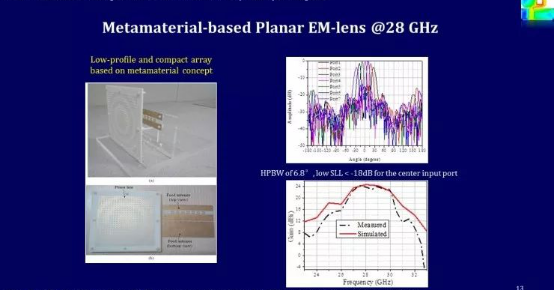
This PPT shows an antenna used in the 28GHz millimeter wave frequency band and uses 7 element antennas as feed sources.
As shown on the left, the front lens is a screen lens made of metamaterials, and two layers of PCB are carved into different shapes to adjust the phase to achieve focusing in a specific direction. The performance of 7 radiating elements can be seen on the right, the lobe width is 6.8°, the side lobe is below 18dB, and the gain is 24-25dB.
This experiment verified the application of electromagnetic lenses in base stations and also verified the role of metamaterial technology in antenna miniaturization.
Millimeter wave antenna design
As we all know, 5G will have two frequency bands, low frequency band and millimeter wave, and millimeter wave has a short wavelength and a lot of loss. Therefore, in 5G communication, we must solve this problem.
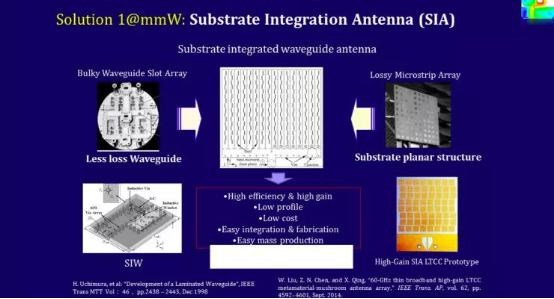
The first solution is a substrate integrated antenna (SIA).
This kind of antenna is mainly based on two technologies: the loss caused by the medium is very small when the hollow waveguide is transmitted, so the hollow waveguide can be used for feed transmission. But there are several problems. Because it is an air waveguide, it is very large in size and cannot be integrated with other circuits, so it is more suitable for high-power and large-volume application scenarios; the other is microstrip technology, which can be mass-produced, but It itself has a large loss as a transmission medium, and it is difficult to form a large-scale antenna array.
Based on these two technologies, substrate-integrated waveguide technology can be produced. This technology was first proposed by the Japanese industry. In 1998, they published the first paper on the waveguide structure of dielectric integration. They mentioned that the waveguide is realized on a very thin dielectric substrate, and small pillars are used to block electromagnetic waves to avoid following Expand both sides. This is not difficult to understand. When the distance between the two small columns is a quarter wavelength, the energy will not leak out, which can form high efficiency, high gain, low profile, low cost, easy integration, and low loss.
At the bottom right of the figure above is a 60GHz antenna made on LTCC using this technology, with a gain of 25dB and a size of 8×8 units.
This scheme is suitable for the application of millimeter waves in base stations, and there is another scheme on mobile terminals.
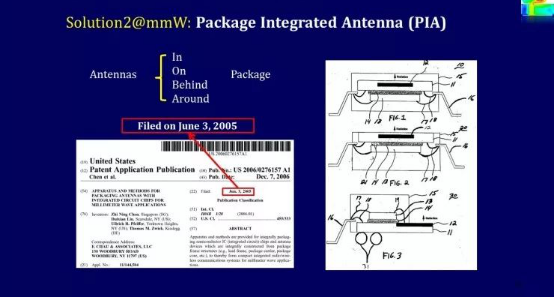
The second solution is to design the antenna in a package (package integrated antenna, or PIA).
Because the biggest problem of the antenna on the chip is that the loss is too large, and the size of the chip itself is small, the design of the antenna will increase the cost, so it is almost impossible to get large-scale application in engineering. If the package (larger than the chip) is used as the carrier to design the antenna, not only a single antenna can be designed, but also an antenna array can be designed, which avoids the volume, loss, and cost constraints of directly making an antenna on silicon.
In fact, the antenna can be designed not only inside the package, but also on the top, bottom, and surroundings of the package.
Another question that needs to be paid attention to is, can a PCB board be used as an antenna? The answer is yes.
The key bottleneck is not the material itself, but the design and processing problems caused by the material. However, PCB is only suitable for frequency bands below 60GHz. LTCC is recommended after 60GHz, but after 200GHz, LTCC also has a bottleneck.
To sum up
In the future, antennas must be designed together with the system instead of separately. It can even be said that the antenna will become a bottleneck of 5G. If this bottleneck is not broken, the signal processing on the system will not be realized, so the antenna has become the 5G mobile communication system. Key technology. The antenna is not just a radiator, it has filtering characteristics, amplifying effect, and suppressing interference signals. It does not need energy to achieve gain, so the antenna is more than just a device.
If you need specific antenna, our factory can develop and produce it, please contact our email: selena@world-ic.com, alex@world-ic.com.

